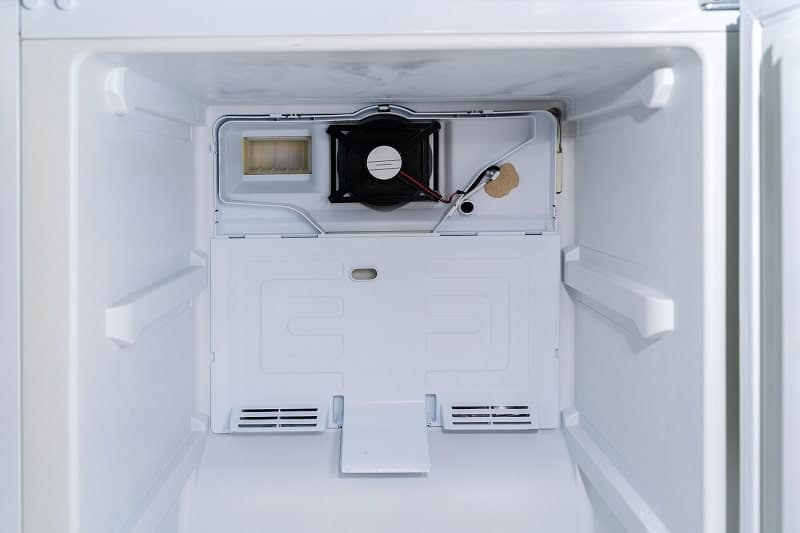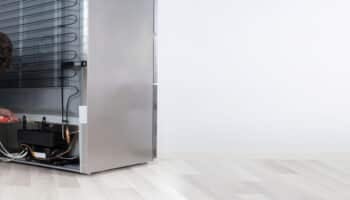We've independently reviewed this article to make sure it's as accurate as we can make it.
To find out more about our article creation and review process, check out our editorial guidelines.
Is food spoiling in your fridge faster than usual?
That sucks! It can be quite frustrating to open your refrigerator and find that all your groceries have gone to waste.
Don’t worry, though. I’m here to help.
If the food is spoiling in your fridge, make sure your food is properly stored, check the door seals, adjust the temperature, and check for airflow issues. It’s also important to clean the condenser coils and examine the defrost system and evaporator fan.
Read on to learn why your food spoils in your fridge!
Why trust us? This article was written by Craig Anderson and Andy Fulenchek.
Craig has helped thousands of other homeowners repair their appliances since 2016.
Andy is one of our resident appliance repair experts with over a decade of experience. He currently runs his appliance repair company with a team of trusted technicians.
How to Keep Food From Spoiling in Your Fridge: 7 Tips
In this section, I’ll guide you through the different reasons that can explain why food spoils in your fridge faster than usual and provide seven solutions to help you forget all about the issue today.
Are you ready? Let’s dive in!
#1 Make Sure Your Food Is Properly Stored
I find that the way you store food in your refrigerator can significantly impact how long it stays fresh.
You see, different areas on your fridge have varying temperatures and humidity levels. Properly organizing your food will prevent moisture loss, avoid cross-contamination, and ensure food hygiene.
Try the following tips to keep your food from spoiling in your fridge:
- Seal your food: Use airtight containers to prevent moisture loss.
- Separate food: Keep raw meat, poultry, and seafood on the bottom shelf and away from other containers to prevent cross-contamination. It’s also important to separate fruit from vegetables because they can emit different gases, which can cause them to spoil faster. Don’t forget to place your fruits and vegetables in the drawers, as they often have higher humidity levels.
- Don’t store dairy products in the door: The door is where the temperature fluctuates the most, so please avoid storing products like eggs or milk there. You should only keep condiments, salad dressings, and soft drinks in the door.
- Label your food: Date-label your containers to indicate when the food was stored. Try to consume older items before newer ones to prevent food waste.
- Avoid overloading your fridge: Overloading your refrigerator can restrict airflow and cause temperature changes.

Don’t forget to clean any spills immediately to prevent cross-contamination and mold growth. Just keep in mind that you should never use bleach when cleaning your fridge. Consider natural alternatives, such as warm water and vinegar.
#2 Adjust the Temperature Dial
In my experience, food can easily spoil if your fridge is not set to the right temperature.
Most refrigerators should sit between 3 °C (37.4 °F) and 5 °C (41 °F). If your fridge is too warm, please adjust the temperature dial.

If your fridge has no built-in digital display and you want to check the temperature, place a glass of water on the middle shelf and leave it there for 8–12 hours. Then, place a regular thermometer in the glass of water.
Note: You can also place an appliance thermometer inside, away from the door.
It’s also crucial to consider ambient temperature. If your fridge is located near heat sources (like an oven) or in a garage, it will struggle to maintain its temperature, leading to food spoilage.
If you’ve adjusted the temperature dial, but your fridge is still too warm, please keep reading and try the next fixes.
#3 Check the Door Seals
When I see food spoiling in a fridge, I always check the door seals.
Your fridge’s door seals (or gaskets) are responsible for keeping cold air inside and preventing warm air from entering the unit. Unfortunately, if the seals are dirty or damaged, your refrigerator will need to work harder to maintain the desired temperature, causing your food to spoil.
So, please clean the door seals with a kitchen cleaner (do not use bleach) or warm water and vinegar. Then, look for any signs of damage.
In my opinion, the easiest way to check the door seals is by placing a piece of paper or a $1 bill half inside and half outside the fridge. Close the door and try pulling the paper out. If it slides easily, you probably need to replace the seal.

Note: To ensure you get the right replacement part, you must know your fridge’s model number.
#4 Look for Airflow Issues
Airflow issues can also lead to uneven temperatures throughout your fridge, causing food to spoil quickly.
I recommend checking that the vents inside your fridge aren’t blocked to ensure proper airflow. If necessary, rearrange your food.
It’s also important to check for ice buildup, as it can block the air channels and cause temperature issues. If necessary, defrost your refrigerator.
If you have a single-evaporator fridge, please check the damper door, as it controls how much cold air moves from the freezer to the refrigerator. You’ll notice temperature irregularities and clicking sounds when the damper door malfunctions.
So, please access the damper door and check for any visible signs of damage. It should be able to move freely. If the damper door is stuck, it’s best to call a professional.
Keep in mind that on some models, the damper door is encased in Styrofoam or has adhesive that makes it stick to the wall. Be careful when disassembling it to avoid damage.
While you’re at it, please check the ice dispenser flap. If it’s faulty, warm air can enter the freezer and cause a problem for single-evaporator fridges. Inspect the flap for any signs of visible damage and check for air leaks. Replace it if needed.
#5 Clean the Condenser Coils
If food keeps spoiling in your fridge, please clean the condenser coils.
The condenser coils are typically located at the back or across the bottom of refrigerators and are responsible for dissipating the heat generated during the cooling process.
If you haven’t cleaned the condenser coils in a while, your fridge will need to work harder to maintain the internal temperature, which can lead to food spoilage and unpleasant odors.

Here’s how to clean the condenser coils:
- Unplug your fridge from its power source to prevent electrical hazards.
- Carefully move your fridge to access the condenser coils. If necessary, ask a friend for help.
- Take a soft brush (you can use a toothbrush) to clean the coils.
- Vacuum behind your fridge and wipe down the coils with a damp cloth. Then, use paper towels to dry them.
- Plug your fridge back in.
#6 Check the Evaporator Fan
I tend to find that when food keeps spoiling in a fridge, it’s typically due to a faulty evaporator fan.
You see, the evaporator fan is responsible for circulating cold air throughout the fridge. If it’s faulty, you’ll hear unusual noises and notice that your freezer is cold, but your fridge is warm.

To rule out the evaporator fan as our possible culprit, please refer to the manufacturer’s manual to access it. (It is typically located behind a panel in the freezer compartment). Then, make sure the fan spins freely. If it’s not moving, replace the evaporator fan motor with a new one.
#7 Examine the Defrost System
If you’ve tried all of the fixes above, but food keeps spoiling in your fridge faster than usual, it’s time to inspect the defrost system.
Most refrigerators have a defrost system consisting of different components, like a timer, thermostat, and heater. These parts work together to prevent frost buildup and ensure your fridge maintains the correct temperature.
Unfortunately, if one of the defrost system components malfunctions, ice will accumulate, leading to reduced airflow and inconsistent temperatures. As a result, your food will spoil.
In such cases, my usual advice is to test the timer, thermostat, and heater with a multimeter. If you don’t get the recommended readings by the manufacturer, please replace the faulty component.

Remember, if you’re not comfortable testing or replacing the defrost components yourself, it’s best to call an appliance expert.
Wrapping Up: Your Guide to Fresher Food
Hopefully, now you know how to keep your food fresh.
Remember that if food spoils in your fridge faster than usual, you’ll need to rearrange the containers, check for airflow issues, and set the right temperature. Don’t forget to examine the door seals, clean the condenser coils, inspect the evaporator fan, and check the defrost system components.
Thank you so much for taking the time to read this article. If you ever experience a different issue with your refrigerator, please check out our site.
Have a wonderful day!










